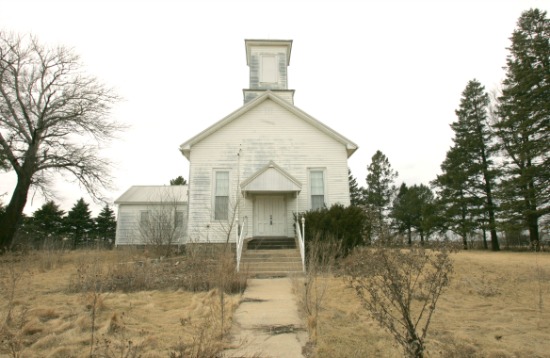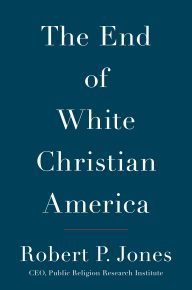
(AP Photo/Waterloo Courier, Dennis Magee)
For most of the twentieth century, in White Christian America the terms “Christian” and “Protestant” were virtually synonymous. Questions like “And where do you go to church?” felt appropriate in casual social interactions or even business exchanges. White Christian America was a place where few gave a second thought to saying “Merry Christmas!” to strangers on the street. It was a world of shared rhythms that punctuated the week: Wednesday spaghetti suppers and prayer meetings, invocations from local pastors under the Friday night lights at high school football games, and Sunday blue laws the shuttered Main Street for the Sabbath.
In its heyday, a set of linked institutions reinforced White Christian America’s worldview across generations: the Young Men’s Christian Association (YMCA), the Boy Scouts, the Masonic Lodge, and the local country club with limits or even outright bans on membership for Catholics, Jews, and ethnic minorities. White Christian America had its golden age in the 1950s, after the hardships and victories of World War II and before the cultural upheavals of the 1960s. June Cleaver was its mother, Andy Griffith was its sheriff, Norman Rockwell was its artist, and Billy Graham and Norman Vincent Peale were its ministers.
To be sure, this seemingly seamless world was never as all encompassing as it pretended. It always operated parallel to the rich religious and cultural domain of African American Protestants. It tacitly acknowledged the notion of the “triple melting pot” offered by sociologist Will Herberg in his 1955 landmark analysis of the American religious tapestry, Protestant, Catholic, Jew, but it never saw these as more than theoretical concessions. For most of the nation’s life, White Christian America was big enough, cohesive enough, and influential enough to pull off the illusion that it was the cultural pivot around which the country turned—at least for those living safely within its expansive confines. But this artifice weakened as White Christian America shrank in size and the power of its institutions dwindled.
The remains of White Christian America can still be seen in the town squares of county seats in the South and Midwest. They are also visible in our oldest cities, where Protestant churches with tall steeples were erected centuries ago to keep a watchful eye over the centers of civic and business power. Today, many of these churches still preserve their core functions: conducting weekly worship services, leading Sunday Schools for children, and organizing charitable work for those in need. But even though the physical structures cast shadows as long as they did in the past, their cultural reach has shortened significantly. There are, to be sure, pockets of the country where the spirit of White Christian America still seems alive and well—like midwestern and southern exurbs, where lively megachurches have followed the outmigration of whites from cities, and rural communities, where churches and pastors continue to have vital social roles. But even within these reassuringly insular settings, it’s no longer possible to believe that White Christian America (WCA) sets the tone for the country’s culture as a whole. And that realization–both for those inside and outside WCA’s domain—marks something genuinely new in American life.
Today, many white Christian Americans feel profoundly anxious. As is common among extended families, WCA’s two primary branches, white mainline and white evangelical Protestants, have competing narratives about WCA’s decline. White mainline Protestants blame evangelical Protestants for turning off the younger generation with their antigay rhetoric and tendency to conflate Christianity with conservative, nationalistic politics. White evangelical Protestants, on the other hand, blame mainline Protestants for undermining Christianity because of their willingness to sell out traditional beliefs to accommodate contemporary culture.
In my new book, The End of White Christian America, I aim to tell a story that rises above intra-family feuding, examining White Christian America as a single dynasty. The key question here is not why one white Protestant subgroup is faring worse than another, but why white Protestantism as a whole—arguably the most powerful cultural force in the history of our country—has faded. This is a story of theology and culture, but it is also a story of powerful demographic changes.
These changes are both visceral and symbolic, affecting everyday religious communities as well as lofty American ideals. The transformations of the iconic religious buildings discussed above are emblematic of broad shifts within the religious world. But there are also striking symbols of change in our national government. There is, for example, no underestimating the impact of our first African American president taking up residence in the White House. The intensely negative reactions to his presidency among some whites—in particular, a series of challenges to the authenticity of his citizenship and his faith—were certainly fueled by the fact that he does not come from the world of White Christian America. In the judicial branch of the federal government, it is also notable that as of 2010—with the retirement of John Paul Stevens, a Protestant, and the 2010 confirmation of Elena Kagan, a Jew—for the first time in its history, the U.S. Supreme Court has no Protestant justices. The current U.S. Supreme Court is comprised of six Catholics and three Jews. To put that into perspective, there have only been twelve Catholics in the 225-year history of the Court, half of whom occupy seats on the bench today. Similarly, only eight Jews have ever served on the Court, three of whom are sitting justices today.
There have also been dramatic shifts on the ground. In 2004, the same year that Americans reelected George W. Bush as president, the U.S. Census Bureau made waves by predicting that by 2050 the United States would no longer be a majority-white nation. Four years later, when Americans elected Barack Obama as their first African American head of state, the Census Bureau lowered that threshold year to 2042. When Obama was reelected in 2012, population experts forecasted that by 2060 whites will see their numbers decline for the first time in American history, while the number of people who identify as multiracial will nearly triple and the number of Hispanics and Asians will more than double. Mark Mather, a demographer with the Population Reference Bureau, summed up the magnitude of these shifts for The New York Times: “No other country has experienced such rapid racial and ethnic change.”
These racial and ethnic changes are dramatic, but they only partially account for the sense of dislocation many whites feel. In order to understand the magnitude of the shift, we have to also assess White Christian America’s waning cultural influence. Although the declining proportion of WCA members can be explained in part by immigration patterns and lower birth rates among white Americans, the other critical factor in declining influence is religious, most notably religious disaffiliation among younger white Americans. It’s impossible to grasp the depth of many white Americans’ anxieties and fears—or comprehend recent phenomena like the rise of the Tea Party in American politics, the zealous tone of the final battles over gay rights, or the racial tensions that have spiked over the last few years—without understanding that, along with its population, America’s religious and cultural landscape is being fundamentally altered.
One reason why the discussions of demographic change have been less focused on religion is that the U.S. Census Bureau has not asked about religious affiliation since 1946; in fact, current law forbids the Census from asking about Americans’ religious beliefs. Fortunately, during the last four decades—the period of the most intense transition—the social sciences began to more systematically measure religious affiliation and change. This analysis draws on two of the largest collections of social scientific survey data in existence: the long-running General Social Survey, conducted between 1972 and 2014 by the National Opinion Research Center at the University of Chicago, and the trove of more than 150,000 telephone interviews conducted by Public Religion Research Institute (PRRI) between 2013 and 2015 among random samples of the U.S. adult population. In examining the transitional moment in which we live, my book draws on this data and other sources to document the demise of White Christian America.
Some recent events demonstrate the importance of coming to terms with the passing of White Christian America. In 2014 and 2015, the cities of Ferguson, New York, and Baltimore became hotbeds of protests after white police officers killed unarmed black men. These events have again brought issues of race to the forefront of American consciousness. Nonwhite Americans largely responded to these events with outrage and saw them as obvious examples of racially driven patterns of violence and discrimination against minorities. Many whites, by contrast, regarded the police killings of unarmed black men as isolated incidents. The national turmoil spurred by these events signal the need for white Protestants to deal with the legacies of slavery and segregation and to engage with the country outside the shrinking confines of White Christian America.
In June 2015, the U.S. Supreme Court announced its decision to legalize same-sex marriage nationwide. For the conservative evangelical descendants of White Christian America, this was another isolating moment. While most white mainline Protestants supported the court ruling, as did majorities of Catholics and Jews, white evangelical Protestants remain strongly opposed. Virtually all of the major white evangelical organizations—from the National Association of Evangelicals to the Southern Baptist Convention—doubled down on their opposition to gay marriage ahead of the ruling and reiterated their “no compromise” position afterward. As one of the few major religious groups who remain strongly opposed to same-sex marriage, white evangelicals—especially if they continue to battle fiercely in the courts despite having lost the war—will set the tone for their future relationships with their own younger members and the broader society, not to mention the millions of gay and lesbian Americans.
As sympathetic or unsympathetic as one may be to white Christians’ plight at this critical juncture in American history, one simple fact remains: White Christian America will be survived by significant numbers of its descendants. There is much at stake for the country in whether these survivors retreat into disengaged enclaves, band together to launch repeated rounds of what the sociologist Nathan Glazer has called “defensive offensives”—in which a formerly powerful majority recasts itself as a beleaguered minority in an attempt to preserve its particular social values—or find a way to integrate into the new American cultural landscape.
Robert P. Jones is the CEO of PRRI. He is the author of The End of White Christian America, from which this article was excerpted. Follow him @robertpjones.
From THE END OF WHITE CHRISTIAN AMERICA by Robert P. Jones. Copyright © 2016 by Robert P. Jones. Reprinted by permission of Simon & Schuster, Inc.
